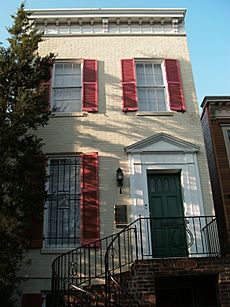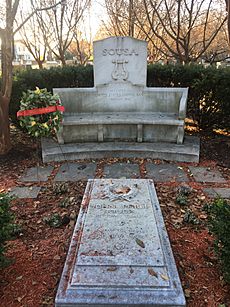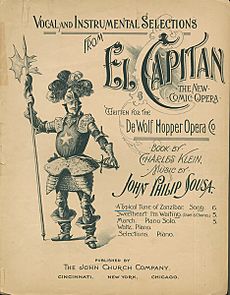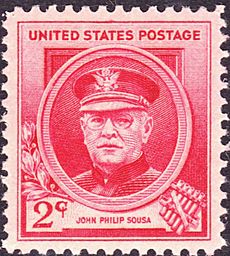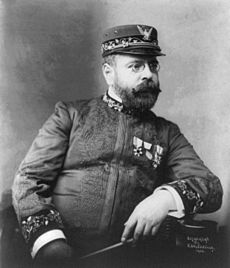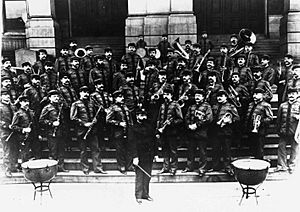John Philip Sousa facts for kids
Quick facts for kids
John Philip Sousa
|
|
|---|---|
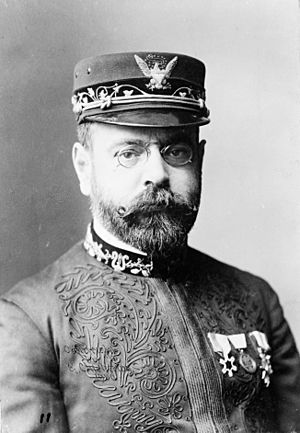
Sousa in 1900; photo by Elmer Chickering
|
|
| Born | November 6, 1854 Washington, D.C., U.S.
|
| Died | March 6, 1932 (aged 77) Reading, Pennsylvania, U.S.
|
| Burial place | Congressional Cemetery |
| Other names | "The (American) March King" |
| Known for |
|
|
Notable work
|
Full list |
| Spouse(s) |
Jane van Middlesworth Bellis
(m. 1879) |
| Children | 3 |
| Military career | |
| Allegiance | United States |
| Service/ |
|
| Years of service |
|
| Rank |
|
| Commands held |
|
| Signature | |
John Philip Sousa ( soo-ZƏ-,_-SOO-sə November 6, 1854 – March 6, 1932) was an American composer and conductor of the late Romantic era known primarily for American military marches. He is known as "The March King" or the "American March King", to distinguish him from his British counterpart Kenneth J. Alford. Among Sousa's best-known marches are "The Stars and Stripes Forever" (National March of the United States of America), "Semper Fidelis" (official march of the United States Marine Corps), "The Liberty Bell", "The Thunderer", and "The Washington Post".
Contents
Early life
John Philip Sousa was born in Washington, D.C.. He was the third of ten children of João António de Sousa (John Anthony Sousa) (September 22, 1824 – April 27, 1892), who was born in Spain to Portuguese parents, and his wife Maria Elisabeth Trinkhaus (May 20, 1826 – August 25, 1908), who was German and from Bavaria.
Music education
Sousa began his music education under the tuition of John Esputa Sr., who taught him solfeggio. However, this was short-lived due to the teacher's frequent bad temper.
Sousa's real music education began in 1861 or 1862 as a pupil of John Esputa Jr., the son of his previous teacher under whom Sousa studied violin, piano, flute, several brass instruments, and singing. Esputa shared his father's bad temper, and the relationship between teacher and pupil was often strained, but Sousa progressed very rapidly and was also found to have perfect pitch. During this period, Sousa wrote his first composition, "An Album Leaf", but Esputa dismissed it as "bread and cheese", and the composition was subsequently lost.
Career outline
Sousa's father was a trombonist in the Marine Band, and he enlisted Sousa in the United States Marine Corps as an apprentice at age 13 to keep him from joining a circus band. That same year, Sousa began studying music under George Felix Benkert. Sousa was enlisted under a minority enlistment, meaning that he would not be discharged until his 21st birthday.
Sousa left the band in 1875, and over the next five years, he performed as a violinist and learned to conduct.
In 1880, he rejoined the Marine Band and served there for 12 years as director, after which Sousa was hired to conduct a band organized by David Blakely, P.S. Gilmore's former agent. Blakely wanted to compete with Gilmore.
From 1880 until his death, Sousa focused exclusively on conducting and writing music. He aided in the development of the sousaphone, a large brass instrument similar to the helicon and tuba.
Upon the outbreak of World War I, Sousa was awarded a wartime commission of lieutenant commander to lead the Naval Reserve Band in Illinois. He then returned to conduct the Sousa Band until his death in 1932. In the 1920s, Sousa was promoted to the permanent rank of lieutenant commander in the naval reserve.
Music
Sousa wrote over 130 marches, 15 operettas, 5 overtures, 11 suites, 24 dances, 28 fantasies, and countless arrangements of nineteenth-century western European symphonic works.
He wrote marches for several American universities, including the University of Minnesota, University of Illinois, University of Nebraska, Kansas State University, Marquette University, Pennsylvania Military College (Widener University), and the University of Michigan.
Marches and waltzes have been derived from many of these stage-works. Sousa also composed the music for six operettas that were either unfinished or not produced: The Devils' Deputy, Florine, The Irish Dragoon, Katherine, The Victory, and The Wolf.
In addition, Sousa wrote a march based on themes from Gilbert and Sullivan's comic opera The Mikado, the elegant overture Our Flirtations, several musical suites, etc. He frequently added Sullivan opera overtures or other Sullivan pieces to his concerts.
Sousa was quoted saying, "My religion lies in my composition."
Personal life
On December 30, 1879, Sousa married Jane van Middlesworth Bellis, who was descended from Adam Bellis who served in the New Jersey troops during the American Revolutionary War. They had three children together: John Philip Jr., Jane Priscilla, and Helen.
Hobbies
Sousa ranked as one of the all-time great trapshooters and was enshrined in the Trapshooting Hall of Fame. He organized the first national trapshooting organization, a forerunner to today's Amateur Trapshooting Association (ATA). He also wrote numerous articles about trapshooting.
Sousa also tried his hand at writing fiction. In his 1902 novella The Fifth String, a virtuoso violinist makes a deal with the Devil for a magic violin with five strings. The first four strings excite the emotions of Pity, Hope, Love, and Joy, but the fifth string, made from the hair of Eve, will cause the player's death once played. The violinist wins the love of the woman he desires, but out of jealous suspicion, she commands him to play the death string, which he does. Sousa published Pipetown Sandy in 1905, which includes a satirical poem titled "The Feast of the Monkeys". He wrote a 40,000-word story entitled "The Transit of Venus" in 1920.
Sousa also wrote the booklet "A manual for trumpet and drum", published by the Ludwig Drum Company with advice for playing drums and trumpet. An early version of the trumpet solo to "Semper Fidelis" was included in this volume.
Death
In his later years, Sousa lived in Sands Point, New York.
He died of heart failure at the age of 77 on March 6, 1932, in his room at the Abraham Lincoln Hotel in Reading, Pennsylvania. Sousa is buried in Washington, D.C.'s Congressional Cemetery. Each November 6 the Marine Band performs Semper Fidelis at Sousa's grave.
His house Wildbank has been designated as a National Historic Landmark, although it remains a private home and is not open to the public.
Interesting facts about John Philip Sousa
- Sousaphone is a modified helicon created in 1893 by Philadelphia instrument maker J. W. Pepper at Sousa's request, using several of his suggestions in its design.
- Sousa was a freemason. On July 15, 1881, the "March King" was initiated into Freemasonry by Hiram Lodge No. 10 (Now Hiram-Takoma Lodge No. 10) in Washington, DC, where he remained an active member until his death in 1932.
- Among other Masonic honors he was named the Honorary Band Leader of the Temple Band of Almas Shriners, the DC-based Chapter of Shriners International. A number of his compositions were for the organization, including the "Nobles of the Mystic Shrine" March.
- Sousa was also a member of the Sons of the Revolution, Military Order of Foreign Wars, American Legion, and the Society of Artists and Composers.
- He was a regular competitor representing the Navy in trapshooting competitions, particularly against the Army. Records indicate that Sousa registered more than 35,000 targets during his shooting career.
- Sousa held a very low opinion of the emerging recording industry. He derided recordings as "canned music", and did not conduct his band when it was being recorded. He conducted on some occasions, though. In 1999, "Legacy" Records released some of Sousa's historic recordings on CD.
- He has surviving descendants today; one of his great-grandsons, John Philip Sousa IV, works as a political activist for the Republican Party.
Honors
- Sousa was decorated with the palms of the Order of Public Instruction of Portugal and the Order of Academic Palms of France.
- He also received the Royal Victorian Medal from King Edward VII of the United Kingdom in December 1901 for conducting a private birthday concert for Queen Alexandra.
- In 1922, Sousa accepted the invitation of the national chapter to become an honorary member of Kappa Kappa Psi, the national honorary band fraternity.
- In 1932, he was initiated as an honorary member of Phi Mu Alpha Sinfonia, a national fraternity for men in music, by the fraternity's Alpha Xi chapter at the University of Illinois.
- The World War II Liberty ship SS John Philip Sousa was named in Sousa's honor. The Marine Band possesses the ship's bell, using it in performances of the "Liberty Bell March".
- In 1952, 20th Century Fox honored Sousa in their Technicolor feature film Stars and Stripes Forever with Clifton Webb portraying him. It was loosely based on Sousa's memoirs Marching Along.
- In 1987, an act of Congress named "The Stars and Stripes Forever" as the national march of the United States.
- In 2012, a crater on the planet Mercury was named in Sousa's honor.
- He was posthumously enshrined in the Hall of Fame for Great Americans in 1976.
John Philip Sousa Award
Even after his death, Sousa continues to be remembered as "The March King" through the John Philip Sousa Foundation. The non-profit organization, founded in 1981, recognizes one superior student in marching band for "musicianship, dependability, loyalty, and cooperation." The John Philip Sousa Foundation provides awards, scholarships, and projects such as The Sudler Trophy, The Sudler Shield, The Sudler Silver Scroll, The Sudler Flag of Honor, The Historic Roll of Honor, The Sudler Cup, The Hawkins Scholarship, National Young Artists, The National Community Band, and The Junior Honor Band Project. He won many honorable awards across his lifetime.
List of compositions
Marches
Sousa wrote over 130 marches, published by Harry Coleman of Philadelphia, Carl Fischer Music, the John Church Company, and the Sam Fox Publishing Company, the last association beginning in 1917 and continuing until his death. Some of his more well-known marches include:
- "Review" (1873) (Sousa's first published march)
- "The Gladiator March" (1886)
- "Semper Fidelis" (1888) (Official March of the United States Marine Corps)
- "The Washington Post" (1889)
- "The Thunderer" (1889)
- "The Loyal Legion March" (1890)
- "High School Cadets" (1890)
- "The Liberty Bell" (1893) (later used as the credits theme for Monty Python's Flying Circus TV series)
- "Manhattan Beach March" (1893)
- "King Cotton" (1895)
- "Stars and Stripes Forever" (1896) (National March of the United States)
- "El Capitan" (1896)
- "Hands Across the Sea" (1899)
- "Hail to the Spirit of Liberty" March (1900)
- "Invincible Eagle" (1901) (dedicated to Pan-American Buffalo Exposition) (Interim United States Space Force Anthem)
- "Imperial Edward" March (1902) Dedicated to King Edward VII of the United Kingdom
- "Fairest of the Fair" (1908)
- "Glory of the Yankee Navy" (1909)
- "Columbia's Pride" (1914)
- "U.S. Field Artillery" (1917) (modified version "The Army Goes Rolling Along" is the official song of the U.S. Army)
- "Anchor & Star" (1918) Dedicated "To the U.S. Navy"
- "Who's Who in Navy Blue" (1920) (composed at the request of the United States Naval Academy class of 1920 and dedicated to Tamanend, a bronze reproduction of the figurehead of the U.S.S. Delaware that occupies a key place at the Academy)
- "The Gallant Seventh" (1922)
- "The Dauntless Battalion" (1922) Dedicated "To Col. Hyatt, the Faculty and Cadets of the Pennsylvania Military College" (Now Widener University in Chester, PA)
- "Nobles of the Mystic Shrine" (1923)
- "The Black Horse Troop" (1924) (written in honor of Troop A, 107th Cavalry, Ohio National Guard).
- "Pride of the Wolverines" (1926)
- "Minnesota March" (1927)
- "New Mexico March" (1928)
- "Salvation Army March" (1930) (dedicated to the Salvation Army's 50th anniversary in the U.S.)
Operettas
Sousa wrote many notable operettas, including:
- Désirée (1883), libretto by Edward M. Taber
- El Capitan (1896), libretto by Charles Klein
- The Charlatan (1898), also known as The Mystical Miss, book by Charles Klein and lyrics by Sousa
- Chris and the Wonderful Lamp (1899), libretto by Glen MacDonough
See also
 In Spanish: John Philip Sousa para niños
In Spanish: John Philip Sousa para niños
- Sousa Archives and Center for American Music
- Academy of Music/Riviera Theatre
- William Bell (tuba player)
- John Philip Sousa Bridge
- Patrick Gilmore


